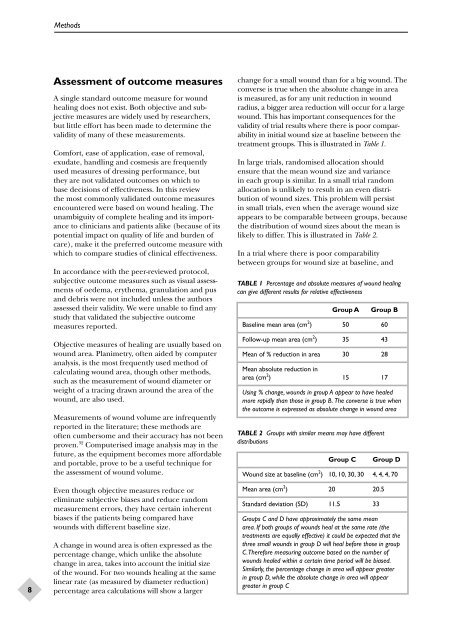Dressings and Topical Agents for Chronic Wounds - NIHR Health ...
Dressings and Topical Agents for Chronic Wounds - NIHR Health ...
Dressings and Topical Agents for Chronic Wounds - NIHR Health ...
You also want an ePaper? Increase the reach of your titles
YUMPU automatically turns print PDFs into web optimized ePapers that Google loves.
Methods8Assessment of outcome measuresA single st<strong>and</strong>ard outcome measure <strong>for</strong> woundhealing does not exist. Both objective <strong>and</strong> subjectivemeasures are widely used by researchers,but little ef<strong>for</strong>t has been made to determine thevalidity of many of these measurements.Com<strong>for</strong>t, ease of application, ease of removal,exudate, h<strong>and</strong>ling <strong>and</strong> cosmesis are frequentlyused measures of dressing per<strong>for</strong>mance, butthey are not validated outcomes on which tobase decisions of effectiveness. In this reviewthe most commonly validated outcome measuresencountered were based on wound healing. Theunambiguity of complete healing <strong>and</strong> its importanceto clinicians <strong>and</strong> patients alike (because of itspotential impact on quality of life <strong>and</strong> burden ofcare), make it the preferred outcome measure withwhich to compare studies of clinical effectiveness.In accordance with the peer-reviewed protocol,subjective outcome measures such as visual assessmentsof oedema, erythema, granulation <strong>and</strong> pus<strong>and</strong> debris were not included unless the authorsassessed their validity. We were unable to find anystudy that validated the subjective outcomemeasures reported.Objective measures of healing are usually based onwound area. Planimetry, often aided by computeranalysis, is the most frequently used method ofcalculating wound area, though other methods,such as the measurement of wound diameter orweight of a tracing drawn around the area of thewound, are also used.Measurements of wound volume are infrequentlyreported in the literature; these methods areoften cumbersome <strong>and</strong> their accuracy has not beenproven. 32 Computerised image analysis may in thefuture, as the equipment becomes more af<strong>for</strong>dable<strong>and</strong> portable, prove to be a useful technique <strong>for</strong>the assessment of wound volume.Even though objective measures reduce oreliminate subjective biases <strong>and</strong> reduce r<strong>and</strong>ommeasurement errors, they have certain inherentbiases if the patients being compared havewounds with different baseline size.A change in wound area is often expressed as thepercentage change, which unlike the absolutechange in area, takes into account the initial sizeof the wound. For two wounds healing at the samelinear rate (as measured by diameter reduction)percentage area calculations will show a largerchange <strong>for</strong> a small wound than <strong>for</strong> a big wound. Theconverse is true when the absolute change in areais measured, as <strong>for</strong> any unit reduction in woundradius, a bigger area reduction will occur <strong>for</strong> a largewound. This has important consequences <strong>for</strong> thevalidity of trial results where there is poor comparabilityin initial wound size at baseline between thetreatment groups. This is illustrated in Table 1.In large trials, r<strong>and</strong>omised allocation shouldensure that the mean wound size <strong>and</strong> variancein each group is similar. In a small trial r<strong>and</strong>omallocation is unlikely to result in an even distributionof wound sizes. This problem will persistin small trials, even when the average wound sizeappears to be comparable between groups, becausethe distribution of wound sizes about the mean islikely to differ. This is illustrated in Table 2.In a trial where there is poor comparabilitybetween groups <strong>for</strong> wound size at baseline, <strong>and</strong>TABLE 1 Percentage <strong>and</strong> absolute measures of wound healingcan give different results <strong>for</strong> relative effectivenessGroup AGroup BBaseline mean area (cm 2 ) 50 60Follow-up mean area (cm 2 ) 35 43Mean of % reduction in area 30 28Mean absolute reduction inarea (cm 2 ) 15 17Using % change, wounds in group A appear to have healedmore rapidly than those in group B. The converse is true whenthe outcome is expressed as absolute change in wound areaTABLE 2 Groups with similar means may have differentdistributionsGroup CGroup DWound size at baseline (cm 2 ) 10,10,30,30 4,4,4,70Mean area (cm 2 ) 20 20.5St<strong>and</strong>ard deviation (SD) 11.5 33Groups C <strong>and</strong> D have approximately the same meanarea. If both groups of wounds heal at the same rate (thetreatments are equally effective) it could be expected that thethree small wounds in group D will heal be<strong>for</strong>e those in groupC.There<strong>for</strong>e measuring outcome based on the number ofwounds healed within a certain time period will be biased.Similarly, the percentage change in area will appear greaterin group D, while the absolute change in area will appeargreater in group C
















